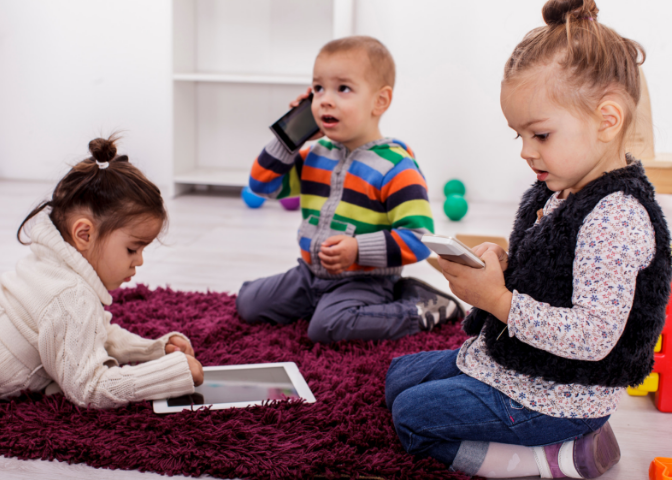
This post is a labor of love, a personal research project months (years) in the making. This was almost two posts but, really, Internet safety and screen-time balance for kids are two topics intricately linked. We have kids who love devices – WE love our devices. They are powerful and amazing and I am grateful for what they can provide me and my kids in terms of education, hobbies (robotics!), and the general navigation of life.
That said, the research is pouring in stating that we don’t know much about how extended screen-time affects young, developing brains. But what we can prove thus far is NOT GOOD. In light of this, and as we publicly announced, we are a screen-lite family. We use devices, we have them, but we try to encourage our kids (and ourselves) to live in fully engaged relationships and to get off the screen and into the world. This means that sometimes the kids are bored (gasp!) and sometimes we get frustrated that we can’t mindlessly scroll through blogs on a rainy Sunday morning (maybe that’s just me) without being incredibly aware of the example we are setting.

Also, it means challenges to our rules (“all the other kids in the world get to do it”) and many tough conversations and decisions about what’s right for our family, and what Mr. Family Trip and I are comfortable with. It can actually get kind of exhausting but, ultimately, I feel it is a struggle worth continuing. Our role as parents is to keep our kids safe and try to show them what being a good human being means (even though they make their own decisions). And the Internet and mobile devices are not going away. So, alas, we can’t just skip that chapter of parenting.
Given, too, that with more and more exposure to the Internet the safety concerns become more and more real, it’s all so very hard to navigate as a parent.
There are heaps of guilt being leveraged on parents, and carried by parents, over screen-time as well. We are told all the “shouldn’ts” and the “don’ts”, but not a lot of “hows” and “how-tos.” So I decided to compile everything I have read, absorbed, seen and studied thus far and put it into one post – one Full & Comprehensive Guide for Internet Safety and Screen-Time Balance for Kids & Families.
This is in no way meant to be exhaustive, and some of it may not work for your family. Take what I have learned and researched, and make it your own. I welcome your comments below as to what your family has done that you would recommend.
Ultimately, after compiling this and reading the article draft, I realize that so much of these tips come back to us, as parents, not being afraid to be in charge of the situation. With kind, thoughtful, and mindful limits and expectations, and by engaged parenting, we can find the balance needed to help with both Internet safety and screen-time balance.
So what I feel is my gift (doing all the nitty gritty research and putting it into one long post) is also a moment to grab you by the shoulders, stand you up straight, and say, “YOU CAN DO THIS.”
How to Encourage Internet Safety with Your Kids
When it comes to safety, what I have learned is that we have to educate, participate, discuss and monitor. Internet safety is hands-on parenting! All the time! But it’s worth the work.
- Discuss all of it with your kids. Don’t be shy. Start early explaining what information they should and certainly SHOULD NOT give out over the Internet. With age-appropriate guidelines, you will need to discuss what they could and shouldn’t see. But from the outset, of course, kids should learn never to give out their address or phone number to people on the Internet. It seems obvious to us, of course, but remember this is a whole new world for your kids.
- Set rules. In the movie Screenagers, the family came together and wrote clear rules, even having their teenager sign a contract. They modified the written rules as they learned more about what worked or didn’t for their family, but expectations and limitations were always clear with all family members. This applies not only to safety rules, but also to balanced lifestyle agreements.
- When it comes to community/online game playing (especially with chats) be informed! Read how they work, who they can talk to and who can talk to them, ask your children about them. Are there blocking capabilities? Reporting forums? What are the privacy policies?
- Use apps to track activity. We have been using Qustodio for some time and appreciate it. Every day I am provided a digest of what the kids did with their screen time (how much was spent on what), which speaks to balance, but also what sites they were visiting. If anything looks dangerous, we talk about it or I check it out myself.
- Don’t allow unsupervised or unfiltered Internet searching. Qustodio also bounces kids out of sites that are suspicious, with the level of censorship controllable. As soon as that happens, I get an email alert that the kids tried to get on to a blocked site and what that site was. (Thus far, it hasn’t seemed overzealous but, rather, right on the money.) As we all know, the Internet can hold some disturbing information. Unfiltered access to the Internet-at-large is a risk. For the easiest solution, change the settings on the device to be child-friendly. (On an iPhone click here; if your are on an Android click here.)
- Use kid-appropriate apps. This is especially relevant for younger children. For example, YouTube Kids. While still getting slammed for some of the things it allows on its platform, YouTube Kids is still far safer for young children than the general YouTube. When possible and when available, use apps intended for children.
- Think hard about allowing your kids the ability to download apps and purchase items from the store directly. Just know your child. Some are easily swayed, many easily confused, by ads or apps, and the ease of online purchasing means there is a low barrier to entry.
- Research apps and games first. Common Sense Media is a great place to start. Before downloading or using a game or app, educate yourself and your child first.
- Talk about being your kids’ friends on social media. This is a great article discussing both sides of this issue. And a lot of researchers highly recommended that parents have access in some way to view social media accounts as many sexual predators will begin grooming victims by developing rapport through social media posts – by “liking,” commenting in manners that raise red flags, or other behaviors that can appear supportive to an untrained eye. That said, if you do friend your child on social media, stay in the background to let them be who they are.

Once we feel like we’ve got a grip on the sliding-scale of Internet safety, thoughts then turn to “how much is too much?”
Research is pretty clear that kids are, indeed, spending too much time on devices and screens; there are serious health and development ramifications that go along with this fact, too. But devices are simply a part of our modern society and can’t be ignored. And, truthfully, they offer a slew of benefits I am glad I have. Smartphones have changed the world and, I argue, for the better.
Plus, I laugh at the idea of limiting kids to two hours of screen time a day (school-issued tablets make a mockery of that), but, then again, the average seven hours that kids spend on screens each day seems extreme, too. (When it comes to young kids, I love the reasonable stance in this CNN opinion piece.)
It may be a very calm and simple solution: we need to take back our influence, parents, and mindfully and consciously understand when we hand over the screens. Are we thoughtfully building in mindful screen consumption, or are we just using it to stop behavior we don’t want to deal with or hear?
The hard truth we have to face, parents, is that the tablet/phone/TV/device truly shouldn’t be the go-to babysitter. Kids will argue, throw temper tantrums, whine, annoy us, and otherwise do things that we wish they didn’t. It’s part of their growth. Our reaction to these situations every time they occur shouldn’t be to put them in front of a device for our own sanity. Devices are amazing and can help a parent control circumstances and situation. Let’s not shy away from this awesome fact. But I wonder if I give a device to my sons every time there is a behavioral challenge or inconvenience, what am I teaching them? (“Lonely? have a device. Angry you can’t get what you want? just smooth it out with a screen. Tired of listening to the dinner conversation? watch YouTube.” Are these extrapolations seeming too extreme? Possibly not.)
This is a super tough pill to swallow. Because parenting is hard and loud. We deserve breaks. I have just personally challenged myself not to always get out a tablet because it’s the easiest, quietest break there is, or because I think I’ve earned MORE time not being needed by a small human.

How to Encourage Screen-Time Balance in Your Family
- Limit where screens are allowed. A general good rule of thumb: not in the bedrooms (or bathrooms). This serves a dual purpose, in my mind. First, it reminds kids that you can see what they do at any time as they are only using devices in common areas. Second, you can actually see what they do at any time.
- Beyond that, consider when and where else to ban screens and devices. This is OK to do! Consider banning screens from any and all meals (even at the restaurant) or have Sunday afternoons screen-free (I’ll miss you home decorating blogs). Maybe when friends come over, declare a rule of no screens (we’ve been amazed at what kids create and play together without a screen). The hitch is that, parents, we have to be prepared to follow the rule, too.
- Discuss and determine what apps, games, and social media make sense. Some of them are time sucks. Some, it depends on the kid or person or personality, lead to obsessiveness (this is our household challenge). Have good discussions with your kids, as a family, to decide what games and apps lead to slippery slopes. Mr. Family Trip and I also have conversations with our kids about what the screen-time activity is teaching or providing. Not all screen-time is equal. We have parameters around what we feel is acceptable and what we don’t. We communicate that clearly with our children. And while they don’t agree with us (of course), at least they know. Then we feel OK with saying ‘no.’
- Think about using timers or apps that have built-in timers. Facebook is infamous for not having a built-in stop mechanism; scientifically, the infinite scroll is highly addictive. Tablets and phones have the same. A timer serves as a great reality check that 1 hour has already flown by.
- ROLE MODEL GOOD SCREEN HABITS. This has to be the hardest part of this whole article.
I love/hate that iPhones added a screen time usage tracker. (Swipe right to see it.) This widget is a really powerful no-way-to-argue-with-it measure of how often we are on our phones, and what we do while on them.
I started to get a handle on my own habits by setting a personal goal when it comes to this. Psychology Today states that adults spend 11 hours a day interacting with media via a screen. That is INSANE! Think about it: if I sleep 8 hours a night, that only leaves 16 hours a day of waking time. So, as an average adult, I am at my desk at work (in front of a computer) for 8 hours of those 16… That is only 8 hours left. But, according this stat, I then get back on a screen for another 3 of those hours at some point.
Reverse the way we say that: it means that, as an average adult, I spend only 5 hours of a 24 hour day without looking at a screen. Driving, commuting, and chores take up a good portion of that 5 hour block of ‘life off screen,’ of course. So when calculating how much screen-time I do, or don’t, want to see in at the end of my day, I do the math backwards. For example, if I want to stay average (which is still a scary statistic) but I want to watch 2 hours of Madam Secretary before bedtime, that means less than 3 hours of time on my device while waiting at the doctors office, using Google Maps, scrolling through Instagram to grow my following, answering texts, checking weather, ordering online groceries, online Bible studies, yoga Dharma talks…
See how quickly this all adds up? It was a tough moment when I got real with myself on how much screen-time I actually have in my life. (This is especially true for us busy parents who constantly feel as though there aren’t enough hours in the day…what if rethought and reallocated those 5 hours?)
At the very least, we can get to using the Moment app and turn off our push notifications. (YES, ALL – you have no idea how hard they are to resist psychologically and how distracting they are. Honestly, you do not need a push notification for Facebook. Promise.)
If it is simply really hard to role model good screen-time balance to your kids, it’s OK! You are not alone. As I mentioned before, there is a book, How to Break Up With Your Phone, that is a cheeky challenge providing concrete steps and tools to roll back screen-time in your life. I loved it. This article on KQED also has some great, simple tips on how to role model better screen behavior.
Spot When There is a Problem
NetSmartz.org lists the following as red flags that a child is experiencing online enticement:
– Spending increasing time online.
visit netsmartz.org
– Getting upset when he or she is not allowed on their device.
– Taking extra steps to conceal what they are doing online.
– Receiving gifts from people they don’t know.
Some Other Rules About Screen-Time for Kids and Families
- Play, too! If your kids really love a game or an app, play it with them! Understand it, get to know it, and even, perhaps, take screen-time and turn it into bonding time.
- I heard the advice: don’t pull the plug! If your kids make a mistake, taking away Internet access, apps, games, screens, isn’t necessarily an appropriate response (obviously, this is situation-dependent, so use your judgement). But our goal as parents is to teach them how to handle the Internet and screens safely and wisely. Our goal is to help them integrate electronic devices into their lives in a healthy manner. So if a mistake is made, teaching them how to rectify and correct can be a more powerful learning opportunity.
- Report suspicious behavior to authorities.
Parents, the team at The Family Trip is struggling with these issues mightily, too. It is something that (clearly) we think about, discuss, and contend with. But, together, we can teach our kids how to be safe and how to be balanced with this wide, beautiful Internet world. Let’s be in control of how we mindfully approach devices and screen-times not just for the sake of our kids’ and their brains, but also for the sake of our own health and our family relationships.
Useful Links for Family Internet Safety and Screen-Time Balance
- Google Family Link
- NetSmartz.org
- Qustodio
- Screenagers Movie: Screen Time Contract
- Screenagers Movie: Parenting Apps
- CyberTip Report
- Common Sense Media
- People article: How Bad is Screen Time for Kids, Really? (with links, apps and suggestions)
Last Updated on July 25, 2019 by Mrs. Family Trip
